Have you ever caught a glimpse of your cat’s front paws turned outward in a “duck-like” fashion?
It’s a curious sight that can leave many cat owners wondering what it means. As a feline expert, I’m here to share everything you need to know about this fascinating phenomenon.
At first glance, you might think there’s something wrong with your furry friend. But don’t fret – this is actually completely normal behavior for cats.
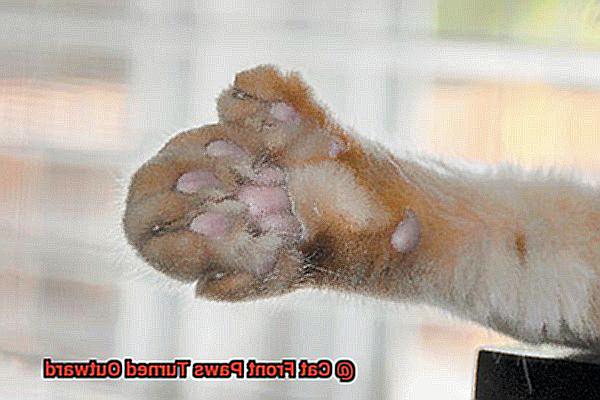
In fact, many breeds have been selectively bred over time to develop this trait. The outward-turning paws provide cats with better grip when they’re running, climbing or jumping.
And the curled back position helps reduce the impact on their joints, making movement easier and more comfortable. While all cats have the ability to turn their paws outward, some breeds like Birman, Siamese and Himalayan are more prone to it due to genetics and breeding habits over time.
So, if you notice your cat’s front paws turned outward – rest assured that it’s just another unique aspect of these amazing creatures we love so much. In conclusion, there’s nothing to worry about if your cat has duck-like feet.
Causes of Cat Front Paws Turned Outward
One of the most common reasons for feline carpal valgus is genetics.
Some breeds, like Persian cats, are more prone to develop this condition than others. Additionally, if a cat’s parents or siblings have this condition, there is a higher likelihood that the cat will also develop it.
Malnutrition can also be a cause of feline carpal valgus. If your cat doesn’t receive proper nutrients during its development, its bones may not grow correctly, leading to deformities such as outward-turning paws.
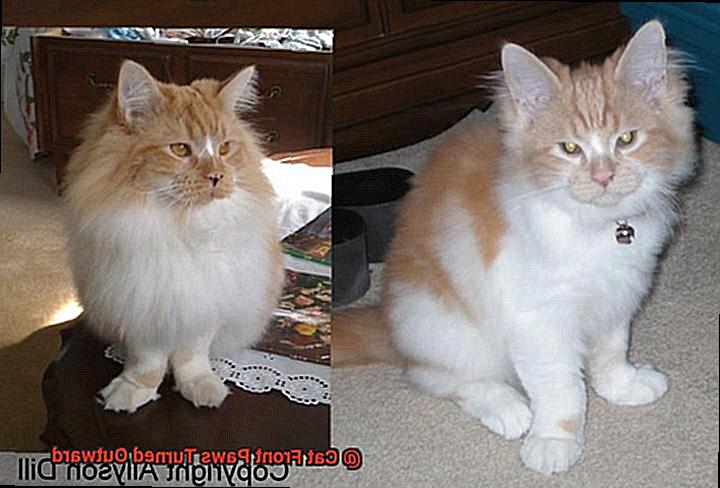
Therefore, it’s vital to ensure that your cat’s diet is balanced and nutritious from an early age. Injuries can also cause feline carpal valgus.
Trauma to the front paws or repetitive stress on the paw joints can result in outward-turning paws. For instance, if your cat spends too much time climbing or jumping, it may lead to wear and tear on the paw joints.
Lastly, certain medical conditions can contribute to feline carpal valgus. Joint problems such as arthritis or hip dysplasia can cause uneven weight distribution on the front legs, resulting in outward-turning paws.
If your cat’s pigeon-toedness is causing them discomfort or interfering with their mobility, seek veterinary attention immediately. Your vet may recommend exercises or physical therapy to help strengthen your cat’s muscles and improve their gait.
Symptoms of Cat Front Paws Turned Outward
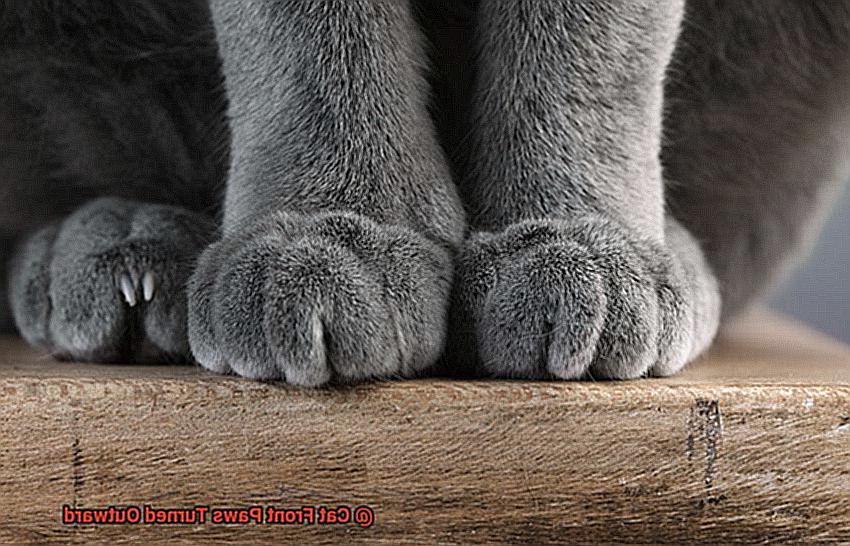
One of the most obvious symptoms to look out for is the positioning of your cat’s front paws.
They should be facing forward, not outward, when standing or walking. Just like how we humans need our feet pointing in the right direction to walk correctly, cats’ paws are also designed to face forward.
So, if you notice their paws turned outward, it could be a sign of a problem. Another symptom to watch out for is limping or difficulty walking.
If your cat is experiencing pain or discomfort in their paws, they may start to limp or struggle with movement. This can also lead to other issues such as arthritis or joint problems if left untreated.
Therefore, it’s crucial to take your furry companion to a vet for a check-up if you notice any limping or struggling during walks. In addition to physical symptoms, changes in behavior can also indicate an issue.
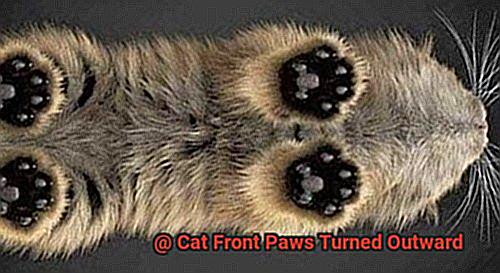
If your cat becomes less active or less interested in playing, it could be due to paw discomfort that limits their movement and playtime. So, pay attention to any changes in their behavior and consult with a veterinarian if necessary.
However, it’s important to note that these symptoms don’t always point to paw-specific problems. They could be a sign of wider issues such as obesity or injuries in other parts of the body.
Therefore, seeking professional help from your vet is crucial in determining the underlying cause and proper treatment. In conclusion, by understanding the symptoms of front paws turned outward in cats, you can better take care of your furry friend and ensure they’re living their best life possible.
Diagnosis of Cat Front Paws Turned Outward
To start off, your veterinarian will conduct a thorough physical examination of your furry friend.
This will involve checking their gait, range of motion, and overall posture to determine the root cause of the issue. If a bone or joint problem is suspected, your vet may recommend X-rays to detect any abnormalities or signs of arthritis.
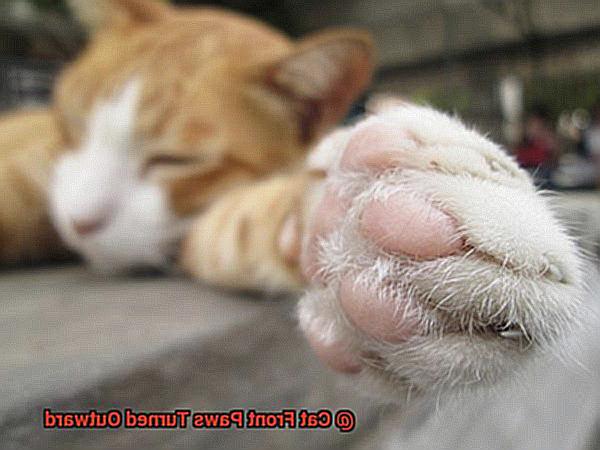
Additionally, blood and urine tests may be conducted to rule out any underlying metabolic conditions that could be contributing to the problem. But that’s not all.
In more severe cases, your veterinarian may refer you to a specialist such as an orthopedic surgeon or neurologist for further evaluation and treatment.
Treatment Options for Cat Front Paws Turned Outward
First and foremost, it’s imperative to schedule a visit with your vet for a comprehensive examination. Your vet will determine the root cause of the issue and develop an individualized treatment plan for your furry friend.
If the issue is due to a birth defect, surgery may be required to realign the bones in their paw. Picture it like a puzzle – all the pieces need to fit back together correctly for everything to align properly.
After surgery, your cat may need physical therapy to help their paw recover. In cases where the issue is due to neurological conditions or nerve damage, medication may be prescribed to manage their pain and inflammation.
Physical therapy can also aid in enhancing muscle strength and coordination. At times, splints or braces may be necessary to support and stabilize their affected paw.

These devices can prevent further damage and provide your beloved kitty’s paw with adequate time to heal correctly. It’s important to remember that treatment should always be administered under the supervision of a veterinarian.
Prevention Tips for Cat Front Paws Turned Outward
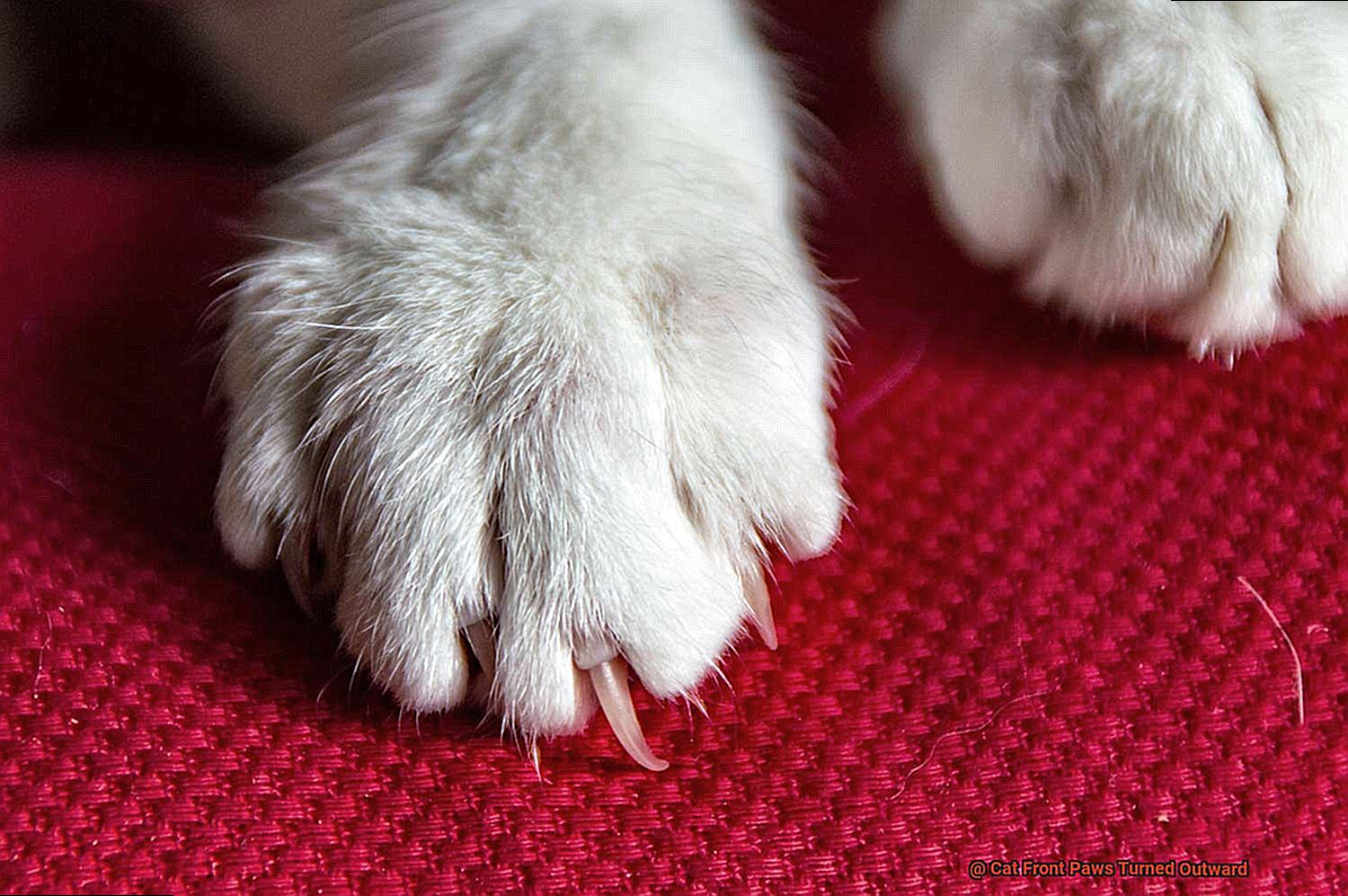
This condition, known as “pigeon-toed” or “toe-out,” can cause discomfort and pain for our furry friends. Fortunately, there are several steps you can take to prevent this issue from occurring or worsening.
Keep Your Cat Active
Regular exercise and playtime are vital for keeping your cat’s muscles strong and flexible. By providing them with opportunities to keep active, you can help prevent any issues with their paws and keep them healthy and happy.
Maintain a Healthy Weight
Obesity is a significant factor in causing joint problems that can lead to conditions like arthritis, which can affect your cat’s ability to walk properly. Feeding your cat a balanced diet and keeping them active can help maintain a healthy weight and reduce the risk of paw problems.
Ensure Proper Nutrition
Proper nutrition is essential for maintaining healthy bones and muscles, which can help prevent any issues with your cat’s paws. Make sure they are eating a balanced and nutritious diet that meets their dietary needs.
Provide Appropriate Scratching Surfaces
Scratching is a natural behavior for cats, but it can cause issues with their paws if they scratch on inappropriate surfaces. Providing appropriate scratching surfaces like scratching posts or pads can prevent any issues caused by scratching.
Keep Their Environment Safe
Cats love to explore, but their curiosity can sometimes get them into trouble. To prevent any injuries or strain on their paws, make sure your home is free from hazards such as sharp objects or potential tripping hazards.
By following these prevention tips, you can help ensure that your cat’s front paws remain healthy and strong, allowing them to live an active and happy life.
However, if you notice any signs of paw problems such as limping or difficulty walking or jumping, it’s crucial to take your cat to the vet as soon as possible for an evaluation and treatment.
How to Help Your Cat with their Gait
If you notice that your feline friend’s front paws are turned outward, it could be a sign of an underlying medical condition or injury. However, don’t fret. There are ways to help your beloved pet move around comfortably and without pain. In this article, we’ll explore five steps you can take to improve your cat’s gait and overall mobility.
Identify the Underlying Issue
The first step in helping your cat with their gait is to identify the cause of the problem. This could be genetics, improper growth and development, or an injury. Taking your cat to the vet for a thorough examination is crucial in determining the underlying condition.
Physical Therapy Exercises
Once you know the cause of the issue, you can take appropriate steps to improve your cat’s gait. Physical therapy exercises are a great way to strengthen your cat’s muscles and increase their range of motion. Your vet or a veterinary physical therapist can recommend exercises that are tailored to your cat’s specific needs.
Comfortable and Supportive Environment

Providing a comfortable and supportive environment for your cat is also essential in improving their gait. This includes soft bedding, low litter boxes, and ramps or steps to help them move around easily. A comfortable environment can help ease any pain or discomfort that your cat may be experiencing.
Seek Veterinary Care
If the issue is due to an injury, it’s crucial to seek veterinary care immediately. Depending on the severity of the injury, surgery may be necessary to correct the problem. Your veterinarian will be able to provide guidance on the best course of treatment for your cat.
Dietary Changes
Finally, making dietary changes can also support your cat’s overall health and mobility. Consult with your vet about the best diet for your cat’s specific needs, as certain foods and supplements can help alleviate joint pain and inflammation.
So, identifying the underlying issue, physical therapy exercises, providing a comfortable environment, seeking veterinary care when necessary, and making dietary changes are all important steps in helping your cat improve their gait and overall mobility.
Remember to always work closely with your veterinarian to ensure that your furry friend receives the best care possible.

When to Seek Veterinary Attention
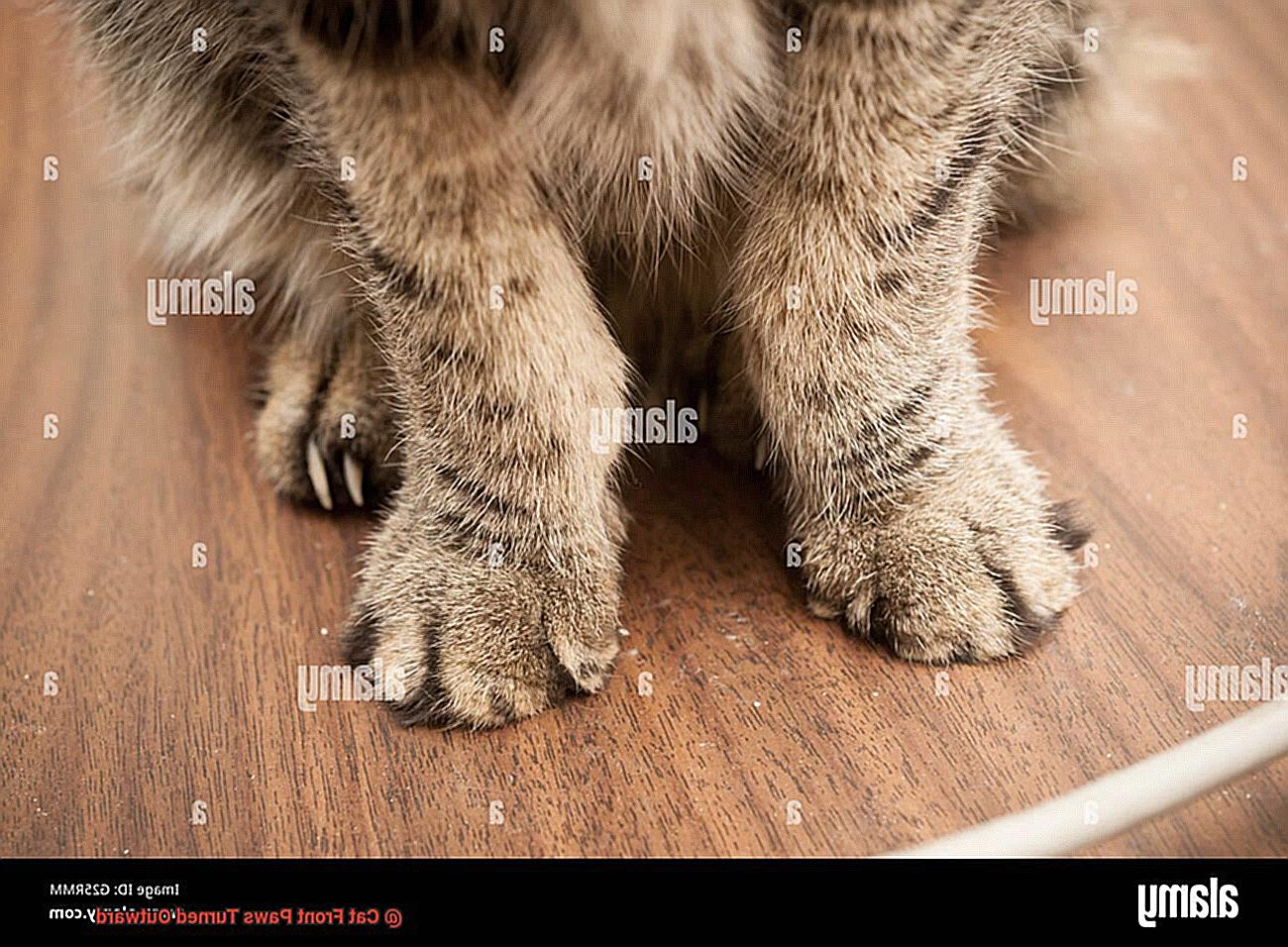
Firstly, if you notice that your cat seems to be in pain or discomfort, it’s time to take a trip to the vet.
This could be a sign of an underlying condition such as arthritis or nerve damage, which require medical treatment. Our furry friends deserve to live a life free from pain just like we do.
If your cat is limping or having difficulty walking, this could be a sign of a more serious condition such as a bone fracture or nerve damage. In these cases, don’t hesitate to seek immediate medical attention for your furry friend.
We want them to recover as soon as possible and get back to their playful selves. It’s also important to look out for sudden changes in your cat’s behavior, appetite, or energy levels.
These could indicate an underlying health issue and should be evaluated by a veterinarian. After all, our cats can’t tell us when something’s wrong, so it’s up to us to be their advocates for good health.
In general, it’s always better to err on the side of caution and seek veterinary attention if you have any concerns about your cat’s health or behavior. Remember, our pets are part of our families and we want them to enjoy happy and healthy lives.
So, if you notice anything out of the ordinary with your furry friend, schedule an appointment with your veterinarian.
Surgical Procedures for Severe Cases
Unfortunately, severe cases of cats with front paws turned outward require surgical procedures as a last resort when all other treatment options have been exhausted.
But don’t worry, there are several surgical options available to improve your cat’s quality of life.
Radial Osteotomy
One common procedure is a radial osteotomy.
Think of it like a puzzle – the affected limb’s radius bone is cut and realigned to correct the deformity. Pins or plates are used to hold the bone in place until it heals properly.
It’s like giving your cat a brand new puzzle to solve. This procedure can significantly improve your cat’s mobility and reduce their pain and discomfort.
Carpal Arthrodesis
Another option is a carpal arthrodesis, which involves fusing the bones in the wrist joint together. It’s like building a sturdy foundation for your cat’s limb, providing stability and reducing pain and discomfort caused by severe deformities.
However, it may limit their range of motion. In extremely severe cases, amputation may be necessary to improve your cat’s quality of life.
Although this option is typically only considered if other treatments have failed, it can alleviate significant pain and discomfort. Removing the affected limb can give your furry friend a fresh start and allow them to live a comfortable and happy life.
It’s important to remember that all surgical procedures come with risks, such as infection, bleeding, and anesthesia complications. That’s why it’s essential to consult with a qualified veterinary surgeon to discuss the risks and benefits for your cat’s specific case.
If you notice any sudden changes in your cat’s behavior, appetite or energy levels, limping or difficulty walking, or if they’re experiencing pain or discomfort with front paws turned outward, seek veterinary attention right away.
ME4pJcJ-7s0″ >
Conclusion
In conclusion, front paws turned outward in cats can either be a normal trait or an indication of a medical condition.
While some feline breeds have been selectively bred to develop this trait for improved grip and joint comfort, it’s important to recognize the potential causes of feline carpal valgus, including genetics, malnutrition, injuries, and certain medical conditions. To help your cat improve their gait and overall mobility, it’s crucial to identify the underlying issue, provide physical therapy exercises, create a comfortable environment, seek veterinary care when necessary, and make dietary changes.
If you notice any signs of paw problems such as limping or difficulty walking or jumping or sudden changes in behavior, appetite, or energy levels – seeking veterinary attention is essential. Severe cases may require surgical procedures like radial osteotomy or carpal arthrodesis to enhance your cat’s quality of life.
Always work closely with your veterinarian to ensure that your furry friend receives the best care possible and lives a happy and healthy life.







